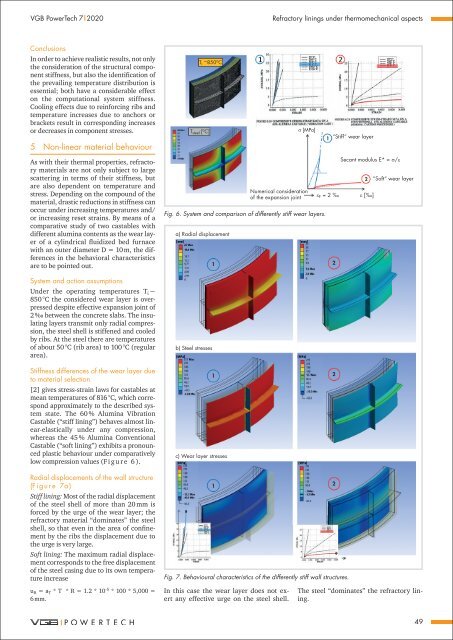VGB POWERTECH 7 (2020) - International Journal for Generation and Storage of Electricity and Heat
VGB PowerTech - International Journal for Generation and Storage of Electricity and Heat. Issue 7 (2020). Technical Journal of the VGB PowerTech Association. Energy is us! Maintenance. Thermal waste utilisation
VGB PowerTech - International Journal for Generation and Storage of Electricity and Heat. Issue 7 (2020).
Technical Journal of the VGB PowerTech Association. Energy is us!
Maintenance. Thermal waste utilisation
You also want an ePaper? Increase the reach of your titles
YUMPU automatically turns print PDFs into web optimized ePapers that Google loves.
<strong>VGB</strong> PowerTech 7 l <strong>2020</strong><br />
Refractory linings under thermomechanical aspects<br />
Conclusions<br />
In order to achieve realistic results, not only<br />
the consideration <strong>of</strong> the structural component<br />
stiffness, but also the identification <strong>of</strong><br />
the prevailing temperature distribution is<br />
essential; both have a considerable effect<br />
on the computational system stiffness.<br />
Cooling effects due to rein<strong>for</strong>cing ribs <strong>and</strong><br />
temperature increases due to anchors or<br />
brackets result in corresponding increases<br />
or decreases in component stresses.<br />
5 Non-linear material behaviour<br />
T i ~ 850 o C<br />
T steel [ o C]<br />
σ [MPa]<br />
1<br />
“Stiff“ wear layer<br />
As with their thermal properties, refractory<br />
materials are not only subject to large<br />
scattering in terms <strong>of</strong> their stiffness, but<br />
are also dependent on temperature <strong>and</strong><br />
stress. Depending on the compound <strong>of</strong> the<br />
material, drastic reductions in stiffness can<br />
occur under increasing temperatures <strong>and</strong>/<br />
or increasing reset strains. By means <strong>of</strong> a<br />
comparative study <strong>of</strong> two castables with<br />
different alumina contents as the wear layer<br />
<strong>of</strong> a cylindrical fluidized bed furnace<br />
with an outer diameter D = 10 m, the differences<br />
in the behavioral characteristics<br />
are to be pointed out.<br />
System <strong>and</strong> action assumptions<br />
Under the operating temperatures T i ~<br />
850 °C the considered wear layer is overpressed<br />
despite effective expansion joint <strong>of</strong><br />
2 ‰ between the concrete slabs. The insulating<br />
layers transmit only radial compression,<br />
the steel shell is stiffened <strong>and</strong> cooled<br />
by ribs. At the steel there are temperatures<br />
<strong>of</strong> about 50 °C (rib area) to 100 °C (regular<br />
area).<br />
Numerical consideration<br />
<strong>of</strong> the expansion joint<br />
Fig. 6. System <strong>and</strong> comparison <strong>of</strong> differently stiff wear layers.<br />
a) Radial displacement<br />
b) Steel stresses<br />
1<br />
ε F = 2 ‰<br />
2<br />
Secant modulus E* = σ/ε<br />
2<br />
ε [‰]<br />
“S<strong>of</strong>t“ wear layer<br />
Stiffness differences <strong>of</strong> the wear layer due<br />
to material selection<br />
[2] gives stress-strain laws <strong>for</strong> castables at<br />
mean temperatures <strong>of</strong> 816 °C, which correspond<br />
approximately to the described system<br />
state. The 60 % Alumina Vibration<br />
Castable (“stiff lining”) behaves almost linear-elastically<br />
under any compression,<br />
whereas the 45 % Alumina Conventional<br />
Castable (“s<strong>of</strong>t lining”) exhibits a pronounced<br />
plastic behaviour under comparatively<br />
low compression values (F i g u r e 6 ).<br />
1<br />
c) Wear layer stresses<br />
2<br />
Radial displacements <strong>of</strong> the wall structure<br />
(F i g u r e 7a )<br />
Stiff lining: Most <strong>of</strong> the radial displacement<br />
<strong>of</strong> the steel shell <strong>of</strong> more than 20 mm is<br />
<strong>for</strong>ced by the urge <strong>of</strong> the wear layer; the<br />
refractory material “dominates” the steel<br />
shell, so that even in the area <strong>of</strong> confinement<br />
by the ribs the displacement due to<br />
the urge is very large.<br />
S<strong>of</strong>t lining: The maximum radial displacement<br />
corresponds to the free displacement<br />
<strong>of</strong> the steel casing due to its own temperature<br />
increase<br />
u R = a T * T * R = 1.2 * 10 -5 * 100 * 5,000 =<br />
6 mm.<br />
1<br />
Fig. 7. Behavioural characteristics <strong>of</strong> the differently stiff wall structures.<br />
In this case the wear layer does not exert<br />
any effective urge on the steel shell.<br />
2<br />
The steel “dominates” the refractory lining.<br />
49


















